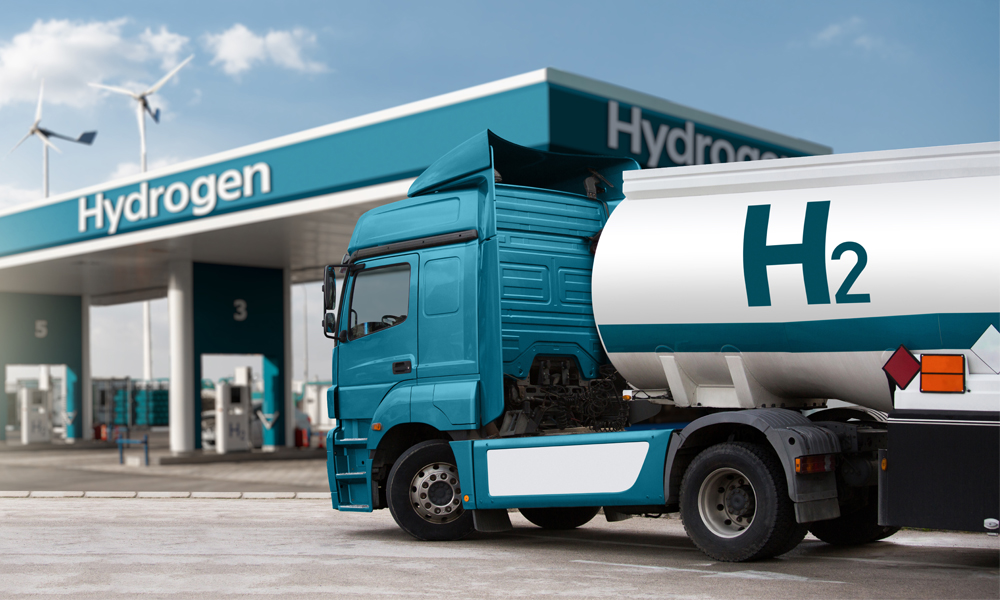
The goal for hydrogen storage is to find a way or material that can storage dihydrogen in an efficient way with respect to the mass- and volume density and of course be able to release and recharge at reasonable temperatures and pressures.
Hydrogen is the most abundant element on Earth with the majority bounded in water (H2O). Hydrogen can be storage in different ways either as a gas, liquid or absorbed or bound in a chemical compound. In the following the focus will be on storing hydrogen as a fuel to run vehicles. The main requirements are that the hydrogen needs to be stored safely and economically. The US Department of Energy has the targets of 6.5 mass% and 62 kg H2 m3 [1].There are two ways of using hydrogen as a fuel to run a vehicles; it can either be burned in an combusting engine together with oxygen or it be burned electrochemically in a fuel cell also together with oxygen with the waste product being water. In the first process the efficiency is limited by the Carnot efficiency and is roughly 25 % where as in the latter case this limitation does not apply and efficiencies as high as 50-60 % may be reached.
Hydrogen may be stored as a gas in high-pressure containers resulting in ~4% hydrogen by mass. The main disadvantages is the price of the high-pressure containers which needs to be able to withstand pressures up to 600 bars and the difference in pressure from inside the tank to where the hydrogen is needed, this will require additional pressure controls. Another aspect is of course the safety of driving around with high pressurized hydrogen.
Hydrogen may also be stored as a liquid and have been used to fuel space shuttles or other forms of aircrafts. Liquid hydrogen has a density of 70.8 kg H2 m3 which meets the targets but unfortunately liquefying the hydrogen requires a lot of energy which lowers the overall efficiency. Hydrogen is also very volatile gas which will build up overpressure is the cryo-tank if this not vented and constant evaporation will result in the loss of hydrogen.
The conventional fossil fuels may also be target for hydrogen storage since these hydrocarbons can rather easily change from single bonds to double bonds by the process of rehydrogenation or dehydrogenation. An example could be the cyclohexane (7.1 mass%) which could be dehydrogenrated to benzene and this process is actually known from chemical plants though converting it to an on-board storage could be complicated. An alternative hydrocarbon source is carbohydrates such as starch or cellulose which have been shown to have a hydrogen content of 14 % which may be released in some enzymatic process [2].
Hydrogen may also be adsorpted on to solid surfaces such as sheets of graphene which provides a hydrogen content of 3.3 mass%. If graphite is ball milled to reach structural sizes in the nano range a content of 7.4 mass% can be achieved though temperatures over 600K is need to desorb the hydrogen. Carbon nanotubes also provide an alternative because of the curved surface the potential fields of opposite walls overlap which results in an increases in the attracting forces working on the hydrogen. This effect could result in an increased uptake of 25 % though at temperatures ~100 K which makes them unsuitable for the on-board storage.
Some research has also been done in the field of ammonia which have a relative high content of hydrogen (5.9 mass% ) which may be released H2 in an appropriate catalytic reformer. Ammonia is produced on a large scale worldwide which means that the mass requirements and distribution is already met. The down side is that ammonia is highly corrosive so a suitable way of storing it would be needed.
Since a high density of hydrogen is wanted the use of lighter elements may be promising such as magnesium. Unfortunately MgH2 requires high temperatures to absorb hydrogen and the process is time consuming. An alternative is to make an alloy containing Mg and e.g. Ni which speeds up the hydrogen formation of the hydride due to the catalytic abilities of the Ni. Another light interesting element is boron which has a high hydrogen content of 18% in LiBH4 but unfortunately again higher temperatures are need to desorb the hydrogen. Boron might be doped with different metals to lower the desorption/adsorption temperature [3].Another large field of hydrogen storage is in metal hydrides which have shown the ability to reversibly absorb large amounts of hydrogen. One of the main advantages is that the metal-hydrogen bond provides a safe way of handling the hydrogen, a high hydrogen density, and all the hydrogen can be released at the same time and pressure. Unfortunately some of the metal hydrides that show the highest hydrogen densities such as PdH0.6 or MgH2 require temperature and pressure conditions to either release or absorb hydrogen beyond the target for the on-board fuel [1]. Other compounds that show promising properties, especially with respect to fast and reversible sorption is LaNi5H6.5 which actually has a density larger than that of liquid hydrogen.
References
[1] Schlapbach L. and Züttel A. , Nature, 414, 2001, 353-358.
[2] Zhang, Y.-H. P., Energy Environ. Sci., 2009, 2, 272–282.
[3] Jepsen, L. H. et al., Materials Today, 17, 3, 2014.
